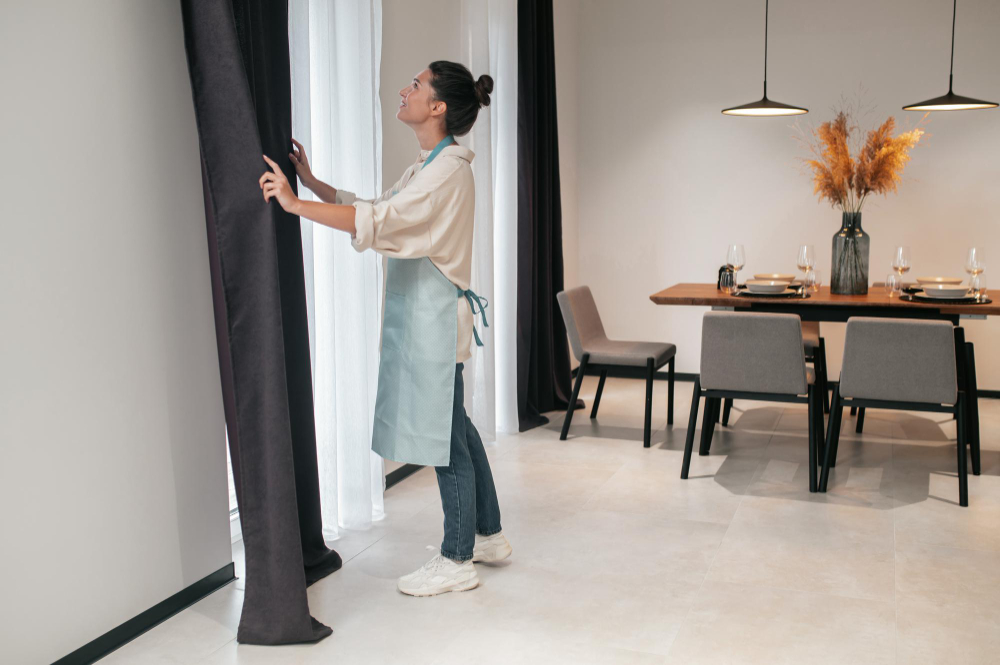Curtains are more than just decorative elements; they play a crucial role in shaping the ambiance and functionality of your living room. Whether you’re looking to enhance privacy, control natural light, or add a touch of style and sophistication to your space, selecting the right curtains is essential. With a myriad of options available in terms of fabric, color, length, and style, it’s essential to consider several factors to ensure you choose curtains that meet your needs and complement your living room decor.
Assessing Your Needs and Preferences
Before embarking on your curtain-shopping journey, take some time to assess your needs and preferences. Consider factors such as the amount of natural light in your living room, the level of privacy you desire, and the overall aesthetic you wish to achieve. Determine whether you want curtains primarily for decorative purposes or if you also need them to provide functional benefits such as insulation or light control. By identifying your priorities upfront, you can narrow down your options and make more informed decisions when selecting curtains.
Choosing the Right Fabric
Fabric choice is a crucial consideration when selecting curtains for your living room. The fabric not only affects the overall look and feel of the curtains but also influences their functionality and durability. Lighter fabrics like sheer or lightweight cotton are ideal for adding a soft, airy feel to the space while allowing ample natural light to filter through. Heavier fabrics such as velvet or brocade provide more insulation and light-blocking properties, making them suitable for rooms where privacy and light control are paramount. Consider the texture, pattern, and maintenance requirements of the fabric to ensure it aligns with your lifestyle and design preferences.
Selecting the Appropriate Length and Width
Properly sizing your curtains is essential for achieving a polished and balanced look in your living room. Curtains that are too short or too narrow can appear awkward and detract from the overall aesthetic of the space. As a general rule of thumb, curtains should extend beyond the window frame to create a sense of height and width, with the bottom hem grazing the floor for a tailored finish. Measure the height and width of your windows accurately and add extra length and width to accommodate fullness and draping, ensuring the curtains cover the entire window when closed.
Considering Curtain Styles and Designs
Curtain styles and designs come in a wide array of options, ranging from traditional to contemporary and everything in between. Popular curtain styles include rod pocket, grommet, pinch pleat, and tab top, each offering a unique look and functionality. Consider the architectural style of your living room, as well as your personal taste and decor theme, when choosing curtain styles. Experiment with different designs, colors, and patterns to add visual interest and personality to your space while ensuring the curtains complement existing furnishings and accessories.
Coordinating Colors and Patterns
When selecting curtain colors and patterns, aim to create a cohesive and harmonious look that ties together the various elements of your living room decor. Consider the existing color scheme, furniture upholstery, and wall paint when choosing curtain colors to ensure they complement rather than clash with the surrounding environment. Opt for neutral tones like white, beige, or gray for a timeless and versatile look, or introduce pops of color and patterns for a more eclectic and vibrant aesthetic. Pay attention to scale and proportion when incorporating patterns to avoid overwhelming the space.
Accessorizing with Curtain Hardware
Curtain hardware, such as rods, finials, and tiebacks, plays a significant role in enhancing the visual appeal and functionality of your curtains. Choose hardware that complements the style and finish of your curtains while also complementing other decorative elements in the room. Consider the weight and length of your curtains when selecting rods and brackets to ensure they can support the curtains without sagging or buckling. Experiment with different hardware finishes, such as brushed nickel, brass, or wrought iron, to add depth and dimension to your window treatments.
Dressing Your Windows with Style and Functionality
In conclusion, selecting curtains for your living room is a multifaceted process that requires careful consideration of various factors, including fabric choice, length, width, style, color, and hardware. By assessing your needs and preferences, choosing the right fabric, sizing your curtains appropriately, and coordinating colors and patterns, you can create a visually stunning and functional window treatment that enhances the beauty and comfort of your living space. Experiment with different styles and designs to find the perfect curtains that reflect your personality and complement your interior decor. With the right curtains, you can elevate the ambiance of your living room while enjoying enhanced privacy, light control, and aesthetic appeal.











+ There are no comments
Add yours